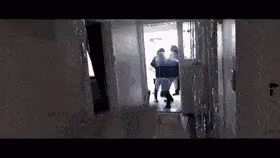“We developed a deep neural network that maps the phase and amplitude of WiFi signals to UV coordinates within 24 human regions. The results of the study reveal that our model can estimate the dense pose of multiple subjects, with comparable performance to image-based approaches, by utilizing WiFi signals as the only input.”
Absolutely ludicrous to paint this development as anything but the wet dream of both a burglar and a police state.
Also VR nerds. Current tracking is either based on the headset, so you can’t move your arms unless the headset can see them, or your arms have to be seen by lighthouses, or you rely purely on gyroscope and accelerometers for tracking, which tend to drift. So either you have blind spots, have to deal with occlusion, or will slowly drift and have to recalibrate periodically. Wifi-based tracking seems like a neat idea tbh.
Edit: considering wifi is just photons that aren’t wiggling fast enough for us to see, I’d be surprised if the government doesn’t already have this technology behind closed doors.
For VR I don’t see why we wouldn’t use a variety of other technologies before we ever use WiFi. The main issue with the WiFi thing is going to be polling rates and interference (which limits polling rates). They’re also using a neural net here which requires both processing power and time so there’s latency far beyond VR uses. That’s without talking about tracking that would be needed for higher spatial resolution which this also doesn’t have currently. So it’s not impossible to use this, just not currently practical or even close.
The real solve to that stuff is just an improvement on existing tech or maybe Lidar. With the progress that has been made on the Quest with hand tracking, I’d bet their next goal is body and face tracking so you’ll see this soon.
As for the government having this, I doubt they really need to have it this specific to track poses or body parts. If you have a cell phone on you, they likely know exactly where you’re at in a room. If you don’t, I’m betting they have access to other important data. Motion detection, number of people, room shape and some contents, interference sources.
Kinect detected bodies damn well. Shame it fell apart
Terrible for games, fantastic for research purposes. Suddenly, everyone could have a highly capable 3D scanner that handily outclassed similar devices worth thousands.
Home automation nerds would also cream their pants if they could get their hands on this. Imagine you could use your existing wifi router to detect presence in your home. Say goodbye to shitty IR sensors that forget about your existence within 3 seconds, no more finicky radar modules that are either too sensitive or not nearly sensitive enough.
I literally just have my machine ping my phone every ten seconds. Surprisingly effective presence detection.
How would one go about setting this up? Because that sounds really cool for home automation.
It’s a very crude way of detecting presence for a variety of reasons, and likely won’t be as useful as you imagine.
The biggest problem is how modern smartphones handle networking when they’re locked. They enter a power saving state where they don’t respond to all pings, or they respond late enough that the pinger decides the device is just not there. Of course there are ways around it, but those are things you need to do explicitly so it won’t work on all devices until you’ve taken the time to set it up.
And since it detects a mobile device’s existence in the local wireless network rather than the actual presence of a human being, it’s not very flexible at all. What if you want to detect the presence of a guest? Are you gonna make sure they’re on your network with their devices set up to properly respond to pings? What if you forgot to turn on your phone’s wifi after turning it off?
I mean it does work once you’ve set it up, but do expect it to have a very limited scope in what you can and cannot do with it.
There is this Home Assistant integration which I remember getting working. I haven’t used Home Assistant in a while though, so I can’t be a good resource if you need any help.
Honestly, I wouldn’t be at all shocked if uncle sam and his favourite three letter agencies have been playing around with this tech for years.
I mean you can look through my walls if you want, but don’t come crying to me if you don’t like what you see.
(I’m painting fantasy miniatures. They’re for a friend.)
Same, but the fantasy miniatures are sex toys and the paint is my butt.
A good hobby is a wonderful thing, indeed!
You give your used toys to your friend? Must be a close relationship
That’s what a bro is for.
Yeah, if they help with painting they can have some too
You know what else let’s you see through walls? Windows. (Suck it, Linux users!)
In more than one sense, yes.
Applicable nick there…
Lead paint coming back into fashion.
I lick that 👍
deleted by creator
“we threw a deep neural network at the wall to see if it sticks”
Time to plaster your outer walls with fine wire mesh.
Lets hope the government is transparent about its use of this technology.
All the information you want to know is available at: REDACTED
Article is from a year ago. Government tends to be ahead of the curve. As an uninformed guess, they have been using it in high value situations for 4+ years.
(Dear FBI, the above is a guess based on public information. I don’t know shit.)
Government tends to be ahead of the curve.
I dunno what world you’re living in, but I live in a world where police still do nearly all their work with pencil and paper and if you want to talk to a police officer, no you can’t talk to them on the phone or send an email. You’ll have to have a meeting face to face.
Sorry, I don’t mean the police.
Actually, police do tend to be reasonably ahead when technology is invasive. I’ve heard many stories about them seeing through walls with other technology. They also tend to like face-tracking, which is pretty advanced. They just are really far behind on technology that could be used to hold them accountable.
Israel has been using a similar system since at least 2022:
https://petapixel.com/2022/06/29/the-xaver-1000-sees-through-walls-and-is-made-for-the-israeli-army/
It’s pretty likely that they have shared this system with their closest allies, similar to how the Trophy missile defense system found its way onto German and American tanks.
By the way, those throwable cameras mentioned at the end of the article have been available to the IDF since 2005.
Which leads to the obvious question: how long has the military been able to do this?
Here’s the summary for the wikipedia article you mentioned in your comment:
TEMPEST is a U. S. National Security Agency specification and a NATO certification referring to spying on information systems through leaking emanations, including unintentional radio or electrical signals, sounds, and vibrations. TEMPEST covers both methods to spy upon others and how to shield equipment against such spying. The protection efforts are also known as emission security (EMSEC), which is a subset of communications security (COMSEC).
Good bot (does this work here?)
Not yet
wdym by “does this work here?”
There was an incredibly annoying and useless bot on Reddit that ranked other bots based on comments like that.
oh lol
Umm, article from Jan 19, 2023. I remember seeing it then. Is there anything new on this?
The paper: [Submitted on 31 Dec 2022] - I’m not sure if it’s out of prepublication yet.
DensePose From WiFi - https://arxiv.org/abs/2301.00250Here’s another tidbit from July 2, 2023 DensePose from WiFi - See through the walls. - https://www.linkedin.com/pulse/densepose-from-wifi-see-through-walls-alejandro-fernández
And another from July 25, 2023 Revolutionary Applications of DensePose From WiFi: Enhancing Corporate Security and Empowering Military Tactical Teams - https://www.linkedin.com/pulse/revolutionary-applications-densepose-from-wifi-enhancing-zack-hamm
Here’s a video summary of the paper I thought did a good job too from two minute papers.
Thank you for the vid link, got a new channel subscribed now. Great starting point to show people and dive down the rabbit hole with.
Here is an alternative Piped link(s):
https://piped.video/kBFMsY5ZP0o
Piped is a privacy-respecting open-source alternative frontend to YouTube.
I’m open-source; check me out at GitHub.
Wasn’t this the plot point of The Dark Knight?

We only have to enter his name to be safe.And everyone thinks Batman was the good guy.
starts putting paint on face
The whole point of that scene was that he was overstepping the line.
But then cops wear Punisher logos and Republicans play Born in the USA at election rallies, so who knows how the masses interpreted it…
That’s just another example of why Batman was literally evil.
Came here to say this!
Yes, but he specifically used cell signals.
If I didn’t have a reason for why Ethernet is superior, I have one now!
… that you CANT see through walls? Seems like a downgrade to me…
Hey, I don’t want IRL wallhacks 😭
I am going to repeat myself forever it seems. We got it wrong when we decided that you only have privacy when someone can’t physically see what you are up to. Nothing else is treated this way. You are not allowed to drive as fast as your car can physically move. You are not allowed to go into anything locked as long as you are able to pick it. You are not allowed to steal whatever you want as long as no one tackles you for it. And yet somehow some way it became understood that merely because someone can get a photo of you they have the legal right to do so.
As if access to better technology means you should follow less moral rules vs the opposite. Someone with a junk camera of the 80s can do far less perving compared to the new cameras+drones out there.
it became understood that merely because someone can get a photo of you they have the legal right to do so.
What jurisdiction is this true? There are certainly times that there is an expectation of privacy and getting a photo of you would be illegal. Easy example: and owner of a store can’t photo you in the dressing room, the even tho they could put a camera in there. It’s the same thing here, there is an expectation of privacy in your home (or for many enclosed and private spaces), so this kind of “picture” would likely already be a violation.
Just about all of them where the government is spying on their residents. Unless you think it’s alright if the government does it?
The poster made the claim:
it became understood that merely because someone can get a photo of you they have the legal right to do so.
And now you’re talking about the government spying. Total non sequitur that has nothing to do with what I was discussing.
The posters claim goes a bit further than just “can get a photo of you”. The poster originally mentions (and it’s integral to the point) that privacy shouldn’t be predicated on the idea that so long as you are behind closed doors (ie not in view) you have the expectation of privacy. You deliberately narrowed the scope. But please understand that technically my car and the contents thereof are covered by a right to privacy. To search my car lawfully in the US you’d require a warrant. Doesn’t matter if my car is parked on the street. But you could lawfully take a photo of me in that car pretty much anywhere in “public” and that would also be considered lawful. So, what exactly is the demarcation? Where is the line drawn and doesn’t that seem rather arbitrary?
The context of the poster you responded to’s point is that the government decides and makes a line between what is private and what isn’t. And that’s further defined and enforced by laws. When you take into account the number of tools governments the world over have developed to spy on their citizens and just how many of those are then made available to or leaked to the public, and further that some of them being used in public are perfectly legal that poster has a point. We did not draw the line in the sand the right way.
To search my car lawfully in the US you’d require a warrant. Doesn’t matter if my car is parked on the street. But you could lawfully take a photo of me in that car pretty much anywhere in “public” and that would also be considered lawful.
The poster said nothing about the state. They were talking about privacy. They gave a long list of things that we aren’t allowed to do even if we are “able” to do them, and then made the false claim that we are allowed to take pictures “just because we can.” Maybe they have beliefs about the line being in the wrong place for other things, but this submission is about a type of picture, and the poster specifically mentioned taking pictures. So me talking about picture makes perfect sense, bringing in the state searching your car makes next to zero sense.
The context of the poster you responded to’s point is that the government decides and makes a line between what is private and what isn’t.
The poster said absolutely zero about the state. None. Zilch. Zip. When you accused me of narrowing the scope, you were actually projecting your expansion of the scope.
But make no mistake about it, if a cop walks by your car and sees a dead body in the back seat, they don’t need to get a warrant to search your car…because there is no expectation of privacy…which is, of course, actually what we are talking about.
Who determines privacy? Who enacts the laws? How is privacy enforced? What happens when you report someone for invasion of privacy? I don’t understand how this issue can have context without mention of the state.
And we are allowed to take pictures just because we can. If I take your picture in public? Just about nothing you can do about it unless it breaches some other law (like what you mentioned with filming in bathrooms). There are specific things I can’t do with that photo, for instance if that person happens to be famous they may have a right to publicity and their image etc. But they don’t have rights to copyright or the like. Could I post their photo in a random online forum claiming they have done something illegal? Nope? Can I blackmail them? Nope. But I can absolutely use their photo in a copyrighted way for art or even business.
I don’t understand how this issue can have context without mention of the state.
Sure, which is why I challenged them over jurisdiction on their false claim that you could take a picture wherever you want. You even seem to agree with me that that is not the case.
Could I post their photo in a random online forum claiming they have done something illegal? Nope?
Because this is libel. You are allowed to say whatever you want, “unless it breaches some other law.” Just like your limits on what pictures you can take are not “just because you can” but “unless it breaches some other law.”
It all comes down to an expectation of privacy. You have none in a public space as what you are doing everyone else can see.
And the implication of their initial point, in the context of the submission, is that this type of “photography” would be allowed because “you can” and I argue that this would already be protected under current law that there is an expectation of privacy behind in your home. Like in many (it not all?) I can’t take a picture of you in your home through a window even if I can see you from a public space, because of the expectation of privacy.
Duh? I don’t think anyone with the right field of study thought this wasn’t possible. It just doesn’t have good use cases.
I’m an EE, and I have serious doubt about this actually working nearly as good as they are putting it. This sort of stuff is hard, even with purpose built radar systems. I’m working with angle estimation in Multipath environments, and that shit fucks your signals up. This may work it you have extremely precisely characterised the target room and walls, and a ton of stuff around it, and then don’t change anything but the motion of the people. But that’s not practical.
It’s Popular Mechanics, of course it doesn’t work as well as they say it does. But the theory has been around a long time.
You are correct, at best this requires some a priori knowledge of the room. You can kind of do basic motion detection blindly though. They are just measuring the channel response via the 802.11 preambles, so for basic presence detection knowing that the channel response is changing is enough.
I was under the impression these experiments required a pre mapped room with EM readings. I don’t think they can watch you like if it was an X-ray but I’d believe it if they could track blobs of moving mass.
Full body vr tracking without sensors?
The human presence sensors based on this are already on the consumer market, we just need to dial up the sensitivity.
There are already smart light bulbs you can buy off the shelf that use radio signals to see when somebody is in the room. Then it can turn on the lights automatically, without a camera or infrared sensor in the area.
Henceforth, the building code shall make mandatory that every room be perfectly grounded Faraday cages (/s).
Still, imagine lethal drones integrated with that technology (of course, they already have infrared, maybe even some adequate wavelength of X-rays).
Nevertheless, pretty cool to see how far we can take preexisting technology with the help of some deep learning layers.
Here’s what they’re putting in the goggles that Infantrymen wear now.
I don’t care to guess what the drones are packing.
What we know about drones is that they have cameras that can discern individuals from 10 km altitude.
What we suspect is that US has Hubble-sized spy satellites that can do almost the same. There were a lot of classified military STS missions.
What is theoretically possible is that US drones and spy sats can function as very large arrays (we do this with astronomical telescopes already) to dramatically increase spatial resolution.
I’d believe it. When I was in the infantry 20 years ago we could see you 3km away with the optics mounted on our machineguns. And several kilometers with cameras mounted on towers. I don’t know how far they went but it was at least 5km because we were directing mortar fire with them and that’s about the range of the mortar system we were using.
Oh I wonder if that’s how the Pic was taken that trump tweeted out of that rocket launch site, people didn’t think it was physically possible for a satellite to have that resolution
It all comes down to the size of the mirror/lense—the bigger, the better. Up to a point. The biggest problem is air currents and different air densities refracting light and distorting the image. That’s what these laser beams are for on photos taken of astronomical observatories—they give reference light spot that can be used to calibrate adaptive optics to current atmospheric conditions reducing distortion.
Based on the cell phone reception in my house, I already suspect it’s a Faraday cage.
near future building insulation will include enhanced EM spectrum insulation, to prevent or distort leakage into the environment
Doesn’t this mean the matrix film was right with their visualization (regardless of orientation)?


















